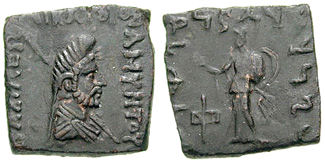Amyntas Nikator on:
[Wikipedia]
[Google]
[Amazon]


 Amyntas Nicator ( grc, Ἀμύντας Νικάτωρ, Amyntas Nikatōr;
Amyntas Nicator ( grc, Ἀμύντας Νικάτωρ, Amyntas Nikatōr;
Coins of Amyntas
{{DEFAULTSORT:Amyntas Nikator Indo-Greek kings 1st-century BC rulers in Asia Euthydemid dynasty


 Amyntas Nicator ( grc, Ἀμύντας Νικάτωρ, Amyntas Nikatōr;
Amyntas Nicator ( grc, Ἀμύντας Νικάτωρ, Amyntas Nikatōr; epithet
An epithet (, ), also byname, is a descriptive term (word or phrase) known for accompanying or occurring in place of a name and having entered common usage. It has various shades of meaning when applied to seemingly real or fictitious people, di ...
means "the Conqueror") was an Indo-Greek
The Indo-Greek Kingdom, or Graeco-Indian Kingdom, also known historically as the Yavana Kingdom (Yavanarajya), was a Hellenistic period, Hellenistic-era Ancient Greece, Greek kingdom covering various parts of Afghanistan and the northwestern r ...
king. His coins have been found both in eastern Punjab
Punjab (; Punjabi: پنجاب ; ਪੰਜਾਬ ; ; also romanised as ''Panjāb'' or ''Panj-Āb'') is a geopolitical, cultural, and historical region in South Asia, specifically in the northern part of the Indian subcontinent, comprising ...
and Afghanistan
Afghanistan, officially the Islamic Emirate of Afghanistan,; prs, امارت اسلامی افغانستان is a landlocked country located at the crossroads of Central Asia and South Asia. Referred to as the Heart of Asia, it is bordere ...
, indicating that he ruled a considerable territory.
Date
Bopearachchi places Amyntas c. 95–90 BCE, whereas Senior places him c. 80–65 BCE.Coinage
Amyntas struck bilingual silver coins with a variety of portraits. Most of these bear the reverse of sitting Zeus holding a victory palm and a small statue of Athena, which according to RC Senior may have indicated an alliance between the house ofMenander I
Menander I Soter ( grc, Μένανδρος Σωτήρ, Ménandros Sōtḗr, Menander the Saviour; pi, मिलिन्दो, Milinda), was a Greco-Bactrian and later Indo-Greek King (reigned c.165/155Bopearachchi (1998) and (1991), respectivel ...
and the house of Antialcidas
Antialcidas Nikephoros ( grc, Ἀντιαλκίδας ὁ Νικηφόρος; epithet means "the Victorious", Brahmi: 𑀅𑀁𑀢𑀮𑀺𑀓𑀺𑀢𑀲 ''Aṃtalikitasa'', in the Heliodorus Pillar) was a king of the Indo-Greek Kingdom, who re ...
. Some of his coins feature the reverse of fighting Athena typical for Menander's descendants. The epithet Nikator (Victor) was previously only used on the Bactrian coins of Agathocles Agathocles (Greek: ) is a Greek name, the most famous of which is Agathocles of Syracuse, the tyrant of Syracuse. The name is derived from , ''agathos'', i.e. "good" and , ''kleos'', i.e. "glory".
Other personalities named Agathocles:
*Agathocles, ...
, a century before Amyntas' reign.
His bronzes feature the syncretic deity Zeus-Mithra
Mithra ( ae, ''Miθra'', peo, 𐎷𐎰𐎼 ''Miça'') commonly known as Mehr, is the Iranian deity of covenant, light, oath, justice and the sun. In addition to being the divinity of contracts, Mithra is also a judicial figure, an all-seeing ...
wearing a phrygian cap and Athena standing at rest, both forming the vitarka mudra.
Amyntas also minted some spectacular Attic coins, the largest silver coins of Antiquity: double-decadrachms, of a weight of 85g. These huge coins were found on the archeological site of Qunduz
Qunduz (Dari: ) is one of the 34 provinces of Afghanistan, located in the northern part of the country next to Tajikistan. The population of the province is around 1,136,677, which is mostly a tribal society; it is one of Afghanistan's most ethni ...
in Afghanistan
Afghanistan, officially the Islamic Emirate of Afghanistan,; prs, امارت اسلامی افغانستان is a landlocked country located at the crossroads of Central Asia and South Asia. Referred to as the Heart of Asia, it is bordere ...
.
Some of these coins use his ordinary Zeus reverse, but some of them used Tyche
Tyche (; Ancient Greek: Τύχη ''Túkhē'', 'Luck', , ; Roman equivalent: Fortuna) was the presiding tutelary deity who governed the fortune and prosperity of a city, its destiny. In Classical Greek mythology, she is the daughter of Aphrodite a ...
in an identical position.
Overstrikes
Amyntas is known to have overstruck coins ofHeliokles II
Heliocles II Dicaeus (Greek: ; epithet means "the just") is thought to have been one of the later Indo-Greek kings and a relative of the Bactrian king Heliocles I. Current scholarly consensus is that he ruled ca 95–80 BCE.
Heliocles II seem ...
.
See also
*Greco-Bactrian Kingdom
The Bactrian Kingdom, known to historians as the Greco-Bactrian Kingdom or simply Greco-Bactria, was a Hellenistic period, Hellenistic-era Hellenistic Greece, Greek state, and along with the Indo-Greek Kingdom, the easternmost part of the Helleni ...
* Greco-Buddhism
Greco-Buddhism, or Graeco-Buddhism, is the cultural syncretism between Hellenistic culture and Buddhism, which developed between the fourth century BC and the fifth century AD in Gandhara, in present-day north-western Pakistan and parts of nort ...
* Indo-Scythians
Indo-Scythians (also called Indo-Sakas) were a group of nomadic Iranian peoples of Scythian origin who migrated from Central Asia southward into modern day Pakistan and Northwestern India from the middle of the 2nd century BCE to the 4th centur ...
* Indo-Parthian Kingdom
The Indo-Parthian Kingdom was a Parthian kingdom founded by Gondophares, and active from 19 CE to c. 226 CE. At their zenith, they ruled an area covering parts of eastern Iran, various parts of Afghanistan and the northwest regions of the Indian ...
* Kushan Empire
The Kushan Empire ( grc, Βασιλεία Κοσσανῶν; xbc, Κυϸανο, ; sa, कुषाण वंश; Brahmi: , '; BHS: ; xpr, 𐭊𐭅𐭔𐭍 𐭇𐭔𐭕𐭓, ; zh, 貴霜 ) was a syncretic empire, formed by the Yuezhi, i ...
References
Further reading
* *External links
Coins of Amyntas
{{DEFAULTSORT:Amyntas Nikator Indo-Greek kings 1st-century BC rulers in Asia Euthydemid dynasty